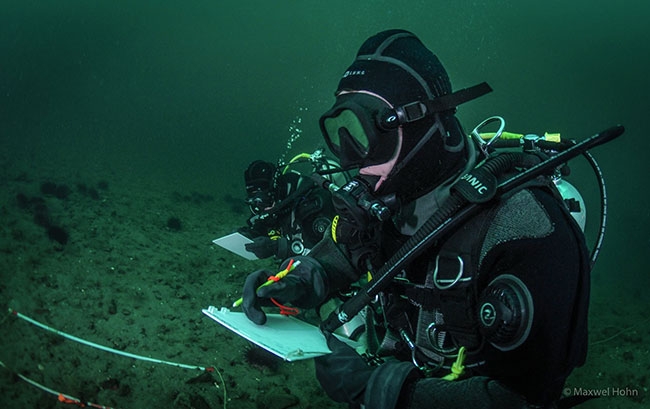
Training the aquaculture diver
June 25, 2019
By Liza Mayer
By nature of farming in the water, there are numerous tasks that need to be tended to that are under the site. This is the domain of the aquaculture diver. These divers use scuba and surface supplied diving apparatus to access the underwater area of the site and perform work and observe and report on the health of the herd in its environment.
 Divesafe students performing biological assessments By nature of farming in the water
Divesafe students performing biological assessments By nature of farming in the waterNot only is the role of the aquaculture diver technically challenging and interesting, it is rewarding to be very hands on in caring for the flock.
One needs to first become a certified diver to get on the dive team. Aquaculture divers are required to become certified as commercial diver. Recreational certification doesn’t cover the “occupational” aspect for the work practices, safety and demand of work.
Aquaculture divers are required to learn the academics of diving, which include the physics and physiology of diving, use of decompression tables, dive medicine and accident management as well as equipment and industry regulations.
In addition to theoretical diving knowledge, dive students have to be well versed in the practical use of the dive equipment in various water situations including currents and poor visibility. Depending on the training standard, divers are required to accumulate bottom time at various depths, doing tasks or projects that they will be required to do in the field. Practical training also includes topside duties such as dive tending, tank filling and equipment maintenance.
During dive training the divers just don’t blow bubbles; they learn and practice work skills, which will come in handy when they get down to the job site under the farm. Dive students learn many crucial skills. The most important, arguably, is knot tying and rigging. Divers need to have a strong ability to tie a number of different knots as well as work with rigging tools, wire rope, chain and shackles. Underwater net sewing is also a skill student divers must master.
To ensure student divers are able to tie knots in all situations, DiveSafe International has the students complete a “Blacked-out knot-tying test.” Student divers wear a full-face mask and have audio communications with a topside instructor. The full-face mask is blacked out with duct tape so the diver is effectively blind folded. The student is then told to tie an assortment of knots and the instructor examines each knot. This exercise ensures that the diver can tie most common knots by feel and in a zero-gravity environment.
In addition to knots, rigging, net and rope work, divers are taught underwater video and still imaging, inspection techniques and report writing. It’s one thing to observe the scene underwater but it’s important that the diver is able to document and describe the situation to the site managers and head office.
Advertisement
- Cargill, InnovaFeed team up for sustainable feed solutions
- Research project showing potential for farming Blue crab





